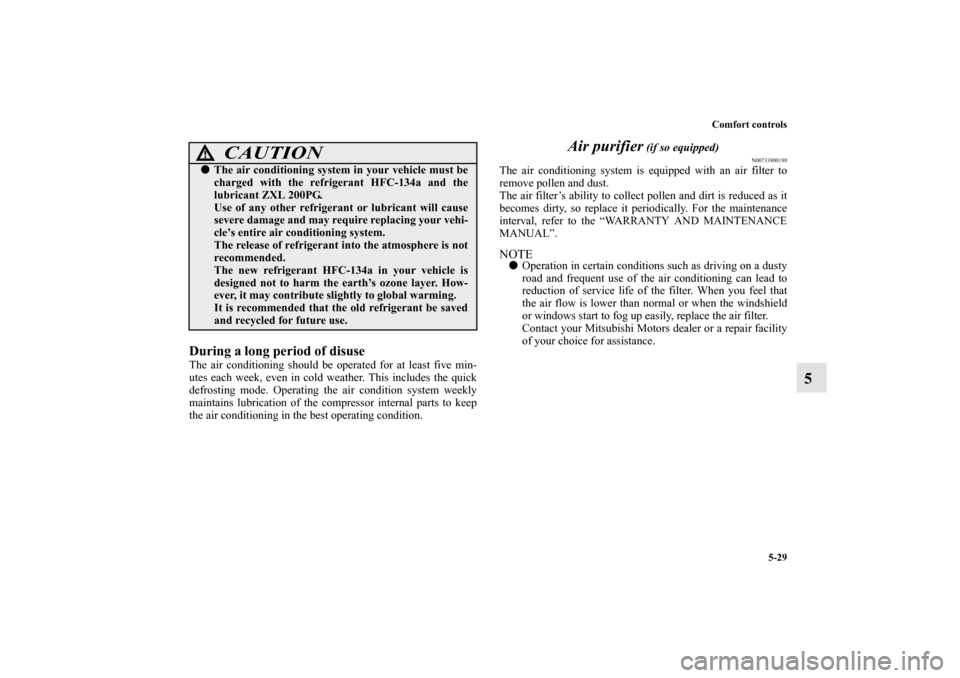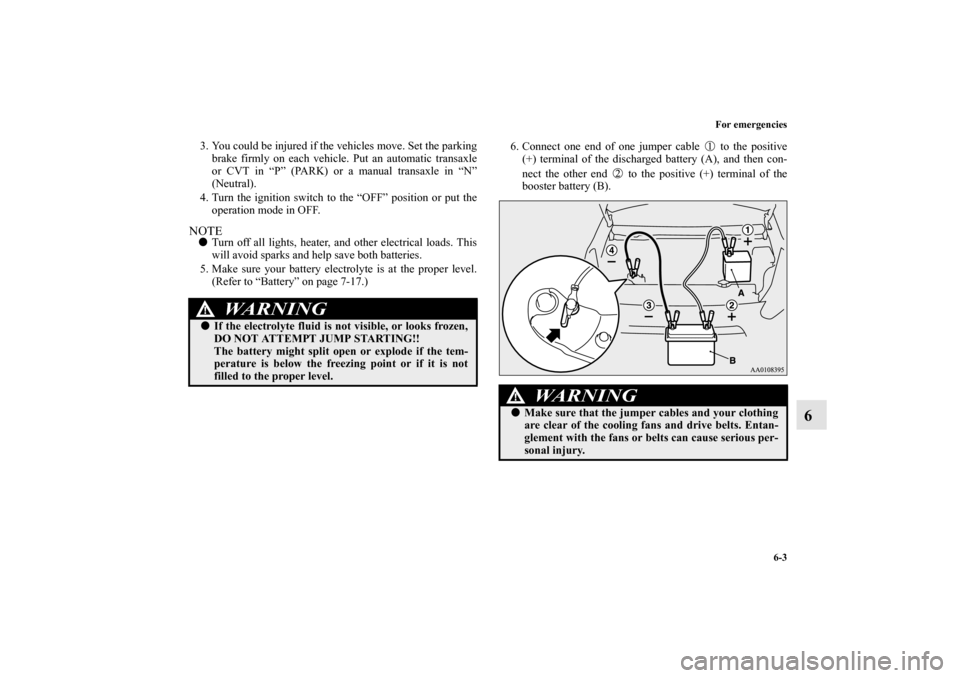Page 295 of 460
Comfort controls
5-23
5
NOTE�The factory setting is “Enable automatic air control”.
�When the defogger switch is pressed, the air selection will
automatically change to the outside air position, even if
the system is set to “Disable automatic air control”, in
order to prevent windows from fogging up.
Air conditioning switch
N00737300343
Push the switch, and the air conditioning compressor will turn
on. The “ ” indicator will be shown in the display (A).
Push the switch again and the air conditioning compressor will
stop and the indicator goes off.
CAUTION
!�Using the air conditioning slightly increases the
engine idle speed. Therefore, make sure your foot is
firmly on the brake pedal when shifting the
transaxle into drive.
BK0162600US.book 23 ページ 2013年3月22日 金曜日 午後2時41分
Page 301 of 460

Comfort controls
5-29
5
During a long period of disuseThe air conditioning should be operated for at least five min-
utes each week, even in cold weather. This includes the quick
defrosting mode. Operating the air condition system weekly
maintains lubrication of the compressor internal parts to keep
the air conditioning in the best operating condition.
Air purifier
(if so equipped)
N00733800180
The air conditioning system is equipped with an air filter to
remove pollen and dust.
The air filter’s ability to collect pollen and dirt is reduced as it
becomes dirty, so replace it periodically. For the maintenance
interval, refer to the “WARRANTY AND MAINTENANCE
MANUAL”.NOTE�Operation in certain conditions such as driving on a dusty
road and frequent use of the air conditioning can lead to
reduction of service life of the filter. When you feel that
the air flow is lower than normal or when the windshield
or windows start to fog up easily, replace the air filter.
Contact your Mitsubishi Motors dealer or a repair facility
of your choice for assistance.
CAUTION
!�The air conditioning system in your vehicle must be
charged with the refrigerant HFC-134a and the
lubricant ZXL 200PG.
Use of any other refrigerant or lubricant will cause
severe damage and may require replacing your vehi-
cle’s entire air conditioning system.
The release of refrigerant into the atmosphere is not
recommended.
The new refrigerant HFC-134a in your vehicle is
designed not to harm the earth’s ozone layer. How-
ever, it may contribute slightly to global warming.
It is recommended that the old refrigerant be saved
and recycled for future use.
BK0162600US.book 29 ページ 2013年3月22日 金曜日 午後2時41分
Page 335 of 460

Comfort controls
5-63
5
�In the following circumstances, moisture can form on
compact discs and inside the audio system, preventing
normal operation.
• When there is high humidity (for example, when it is
raining).
• When the temperature suddenly rises, such as right after
the heater is turned on in cold weather.
In this case, wait until the moisture has had time to dry
out.
�When the CD player is subjected to violent vibrations,
such as during off-road driving, the tracking may not
work.
�When storing compact discs, always store them in their
separate cases. Never place compact discs in direct sun-
light, or in any place where the temperature or humidity is
high.
�Never touch the flat surface of the disc where there isn’t a
label. This will damage the disc surface and could affect
the sound quality. When handling a compact disc, always
hold it by the outer edge and the center hole.
�To clean a disc, use a soft, clean, dry cloth. Wipe directly
from the center hole toward the outer edge. Do not wipe in
a circle. Never use any chemicals such as benzine, paint
thinner, a disc spray cleaner, or an anti-static agent on the
disc.
�Do not use a ball point pen, felt pen, pencil, etc. to write
on the label surface of the disc. �Do not put additional labels or stickers on compact discs.
Also, do not use any compact disc on which a label or
sticker has started to peel off or any compact disc that has
stickiness or other contamination left by a peeled-off label
or sticker. If you use such a compact disc, the CD player
may stop working properly and you may not be able to
eject the compact disc.
BK0162600US.book 63 ページ 2013年3月22日 金曜日 午後2時41分
Page 338 of 460
5-66 Comfort controls
5
Weak reception (fading)Because of the limited range of FM signals and the way FM
waves transmit, you may experience weak or fading FM recep-
tion. When the broadcast is blocked by mountains or similar
obstructions, reception can be disturbed.ReflectionThe reason why one can hear FM but not AM in parking
garages, under bridges etc., is that FM signals, unlike AM sig-
nals, are reflected by solid objects such as buildings, etc.
Because FM signals are easily reflected by buildings, this can
also cause reception disturbances.
The direct signal from the broadcast station reaches the antenna
slightly before the reflected signal. This time difference may
cause some reception disturbance or flutter.
This problem occurs primarily in urban areas.BK0162600US.book 66 ページ 2013年3月22日 金曜日 午後2時41分
Page 339 of 460
Comfort controls
5-67
5
Cross modulationIf one listens to a weak station and is in the vicinity of another
strong station, both stations might be received simultaneously.FM stereo receptionStereo reception requires a high quality broadcast signal. This
means that types of disturbances mentioned previously become
more marked and the reception range is somewhat diminished
during stereo reception.
Causes of disturbancesFM reception is affected by the electrical systems of vehicles in
the vicinity, especially those without an electronic noise sup-
pression device. The disturbance is even greater if the station is
weak or poorly tuned.
FM reception is not as sensitive to electrical disturbances as
AM. AM reception is sensitive to electrical disturbances such
as power lines, lightning and other types of similar electrical
phenomena.
BK0162600US.book 67 ページ 2013年3月22日 金曜日 午後2時41分
Page 342 of 460

6-2 For emergencies
6If the vehicle breaks down
N00836300233
If your vehicle breaks down on the road, move to the shoulder
and turn on the hazard warning flashers. If there is no shoulder,
or the shoulder is not safe, drive in the right lane slowly with
the hazard lights flashing until you come to a safe stopping
place. Keep the flashers flashing.If the engine stops/failsIf the engine stops, there will be no power assist to the steering
and brakes, making these difficult to use.
�The brake booster will not work, so the brakes will not
grip well. The brake pedal will be harder to press than
usual.
�Since there is no power steering assist, the steering wheel
will be hard to turn.When the engine fails at the intersectionGet help from your passengers, bystanders, etc. to push the
vehicle and move it to a safe area.
Jump-starting the engine
N00836400768
If the engine cannot be started because the battery is weak or
dead, you can start it with the battery from another vehicle
using jumper cables.NOTE�Do not use jumper cables if they have damage or corro-
sion.
1. Take off any metal jewelry such as watch bands or brace-
lets that might create an accidental electrical contact.
2. Position the vehicles close enough together so that the
jumper cables can reach, but be sure the vehicles aren’t
touching each other.
WA R N I N G
!�To reduce the risk of igniting flammable gas that
may be emitted from the battery, carefully read this
section before jump-starting the vehicle.�Do not try to start your vehicle by pushing or tow-
ing. This can cause an accident resulting in serious
injury or death and can damage the vehicle.
CAUTION
!�Check the other vehicle. It must have a 12-volt bat-
tery. If the other system isn’t 12-volt, both systems
can be damaged.
BK0162600US.book 2 ページ 2013年3月22日 金曜日 午後2時41分
Page 343 of 460

For emergencies
6-3
6
3. You could be injured if the vehicles move. Set the parking
brake firmly on each vehicle. Put an automatic transaxle
or CVT in “P” (PARK) or a manual transaxle in “N”
(Neutral).
4. Turn the ignition switch to the “OFF” position or put the
operation mode in OFF.NOTE�Turn off all lights, heater, and other electrical loads. This
will avoid sparks and help save both batteries.
5. Make sure your battery electrolyte is at the proper level.
(Refer to “Battery” on page 7-17.)6. Connect one end of one jumper cable to the positive
(+) terminal of the discharged battery (A), and then con-
nect the other end to the positive (+) terminal of the
booster battery (B).
WA R N I N G
!�If the electrolyte fluid is not visible, or looks frozen,
DO NOT ATTEMPT JUMP STARTING!!
The battery might split open or explode if the tem-
perature is below the freezing point or if it is not
filled to the proper level.
WA R N I N G
!�Make sure that the jumper cables and your clothing
are clear of the cooling fans and drive belts. Entan-
glement with the fans or belts can cause serious per-
sonal injury.
BK0162600US.book 3 ページ 2013年3月22日 金曜日 午後2時41分
Page 345 of 460

For emergencies
6-5
6
As your vehicle has anti-lock brakesIf you drive your vehicle with a low battery charge after the
engine has been started by using jumper cables, the engine may
misfire. This can cause the anti-lock braking system warning
light to blink on and off. This is only due to the low battery
voltage. It is not a problem with the brake system. If this hap-
pens, fully charge the battery and ensure the charging system is
operating properly.
Engine overheating
N00836500365
If the high coolant temperature warning light illuminates dur-
ing the engine is running, the engine may be overheating. If
this happens:
1. Stop the vehicle in a safe place. Turn on the hazard warn-
ing flashers.
2. With the engine still running, carefully raise the engine
hood to vent the engine compartment.
3. Check that the cooling fan is running. If the fan is not
turning, stop the engine immediately and contact an
authorized Mitsubishi Motors dealer or a repair facility of
your choice for assistance.
4. If you see steam or spray coming from under the hood,
turn off the engine.
WA R N I N G
!�To avoid personal injury, keep hands, hair, jewelry
and clothes away from the cooling fan. The cooling
fan can start at any time.
BK0162600US.book 5 ページ 2013年3月22日 金曜日 午後2時41分